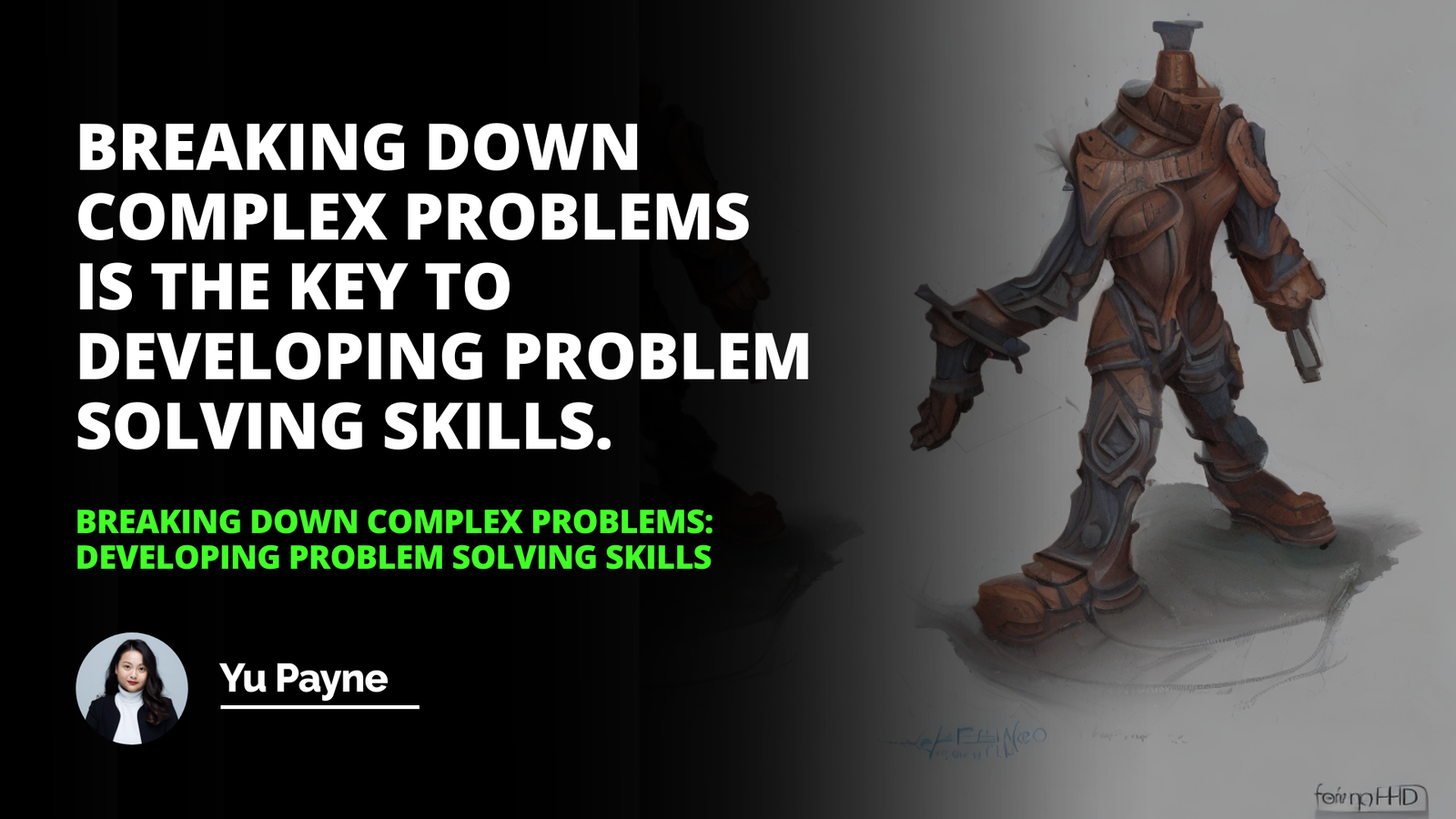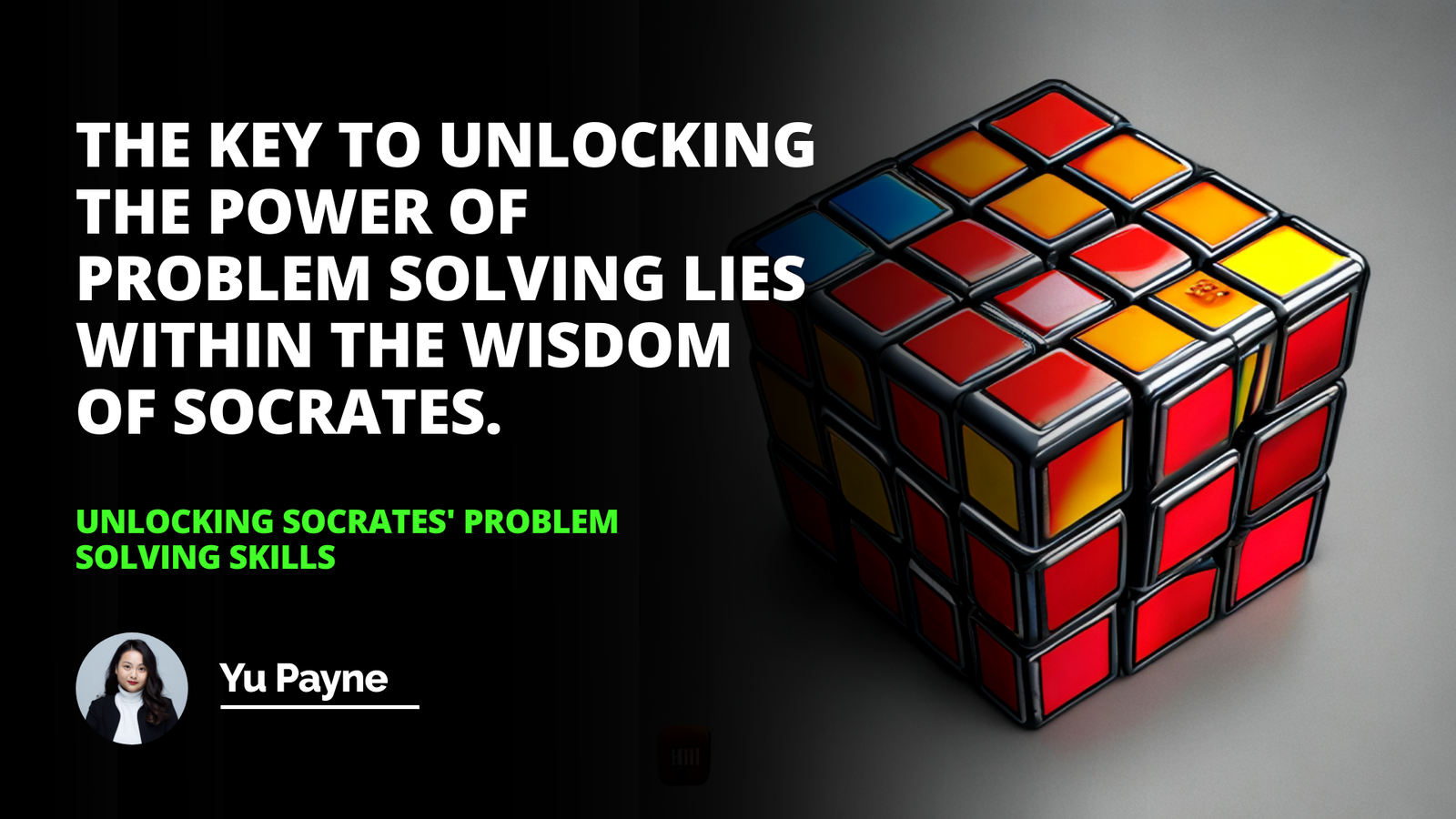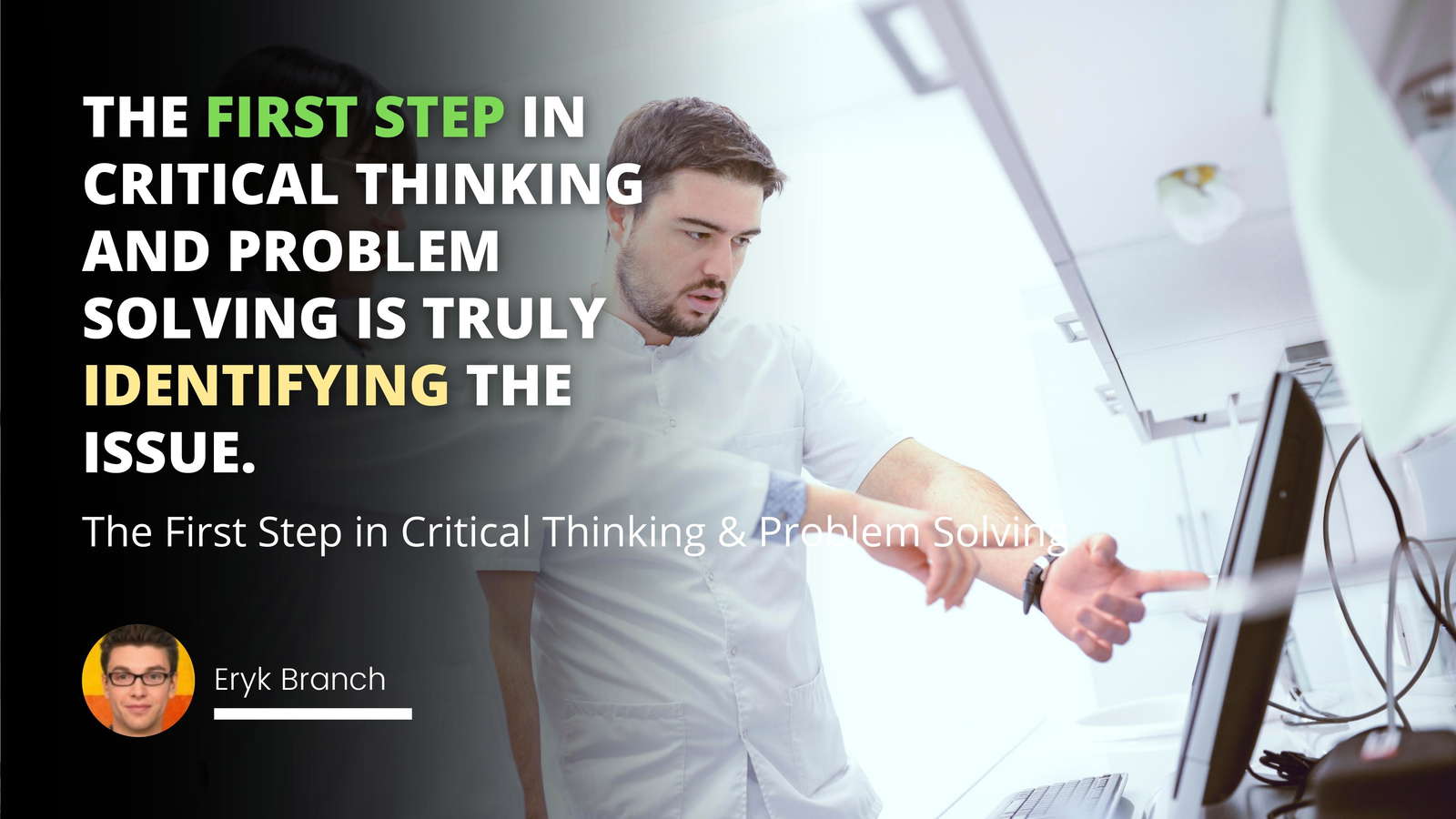
As businesses navigate through uncertain and highly competitive environments, the relevance of robust risk management methodologies becomes ever more apparent. Effective risk management practices do not merely safeguard an organization from potential pitfalls; instead, they provide a structured approach to identifying, evaluating, and proactively addressing risks, ultimately steering decision-making towards more informed and beneficial outcomes.
This article critically examines the intricate role that risk management plays in organizational decision-making, providing a deep dive into its core aspects, processes, and strategic implementations. It showcases, through real-life scenarios and expert analysis, how risk management is indispensable for the corporate health and longevity of organizations.
Understanding Risk Management
Definition of Risk Management: Risk management is the process of identifying, analyzing, assessing, and controlling threats to an organization's capital and earnings. It encompasses a wide range of potential risks, including financial uncertainties, legal liabilities, technology issues, strategic management errors, accidents, and natural disasters. A robust risk management plan allows a business to contain and manage risks with the aim of minimizing their impact or capitalizing on potential opportunities.
Significance and role of Risk Management in organizations: In modern business contexts, risk management serves a critical function across all levels of an organization. It ensures that management teams are equipped with the tools and insights required to make decisions that protect the company's assets and reputation. Companies that excel in risk management can operate more assuredly and aggressively, secure in the knowledge that they understand potential roadblocks and have plans in place to navigate or avoid them.
Differentiating Risk Management from Crisis Management
Distinctive characteristics of Risk and Crisis Management: While risk management is a preventive measure designed to anticipate and mitigate potential risks before they materialize, crisis management is a reactive process employed once a risk has escalated into an actual emergency or crisis. Crisis management strategies are put into effect to minimize damage and enable the organization to recover as quickly as possible. Risk management, by comparison, is a continuous, proactive process embedded in the organizational strategies.
Illustrative example exhibiting the importance of Risk Management: Consider a technology firm that regularly evaluates its cybersecurity preparedness as part of its risk management protocol. By doing so, the firm can identify potential security loopholes and mitigate them before any data breach occurs, which represents a crucial separation from simply responding to a crisis after the fact.
Components of Effective Risk Management
Identifying potential risks
Explanation of hazard identification: Risk identification is the first step where businesses employ various methods to find and record possible risks that could negatively impact a project or business operation. This can involve brainstorming sessions, checklists, and risk registries to ensure a comprehensive list.
Integrating examples of potential risks in various sectors: For instance, in the construction industry, potential risks might include labor shortages, equipment malfunctions, or supply chain disruptions. Meanwhile, a financial institution might be more concerned with interest rate fluctuations, credit risks, or regulatory changes.
Assessing and analyzing risks
Detailed overview of risk analysis techniques: After risks are identified, the next phase involves a detailed analysis, such as qualitative or quantitative assessment methodologies. These might include cost-benefit analysis, root cause analysis, or failure mode effects analysis (FMEA) to evaluate the severity and likelihood of each risk.
Depicting risk assessment process through real-world examples: A hospital undergoing risk assessment might determine that the likelihood of a power outage is low; however, the impact on critical operations and patient safety could be catastrophic, prompting them to develop detailed contingency plans.
Implementing risk control measures
Discussion on preventive, corrective, and detective control measures: Risk control measures are actions taken to reduce the likelihood and impact of a risk. Preventive controls aim to stop risks before they occur, while corrective controls address them after they have happened. Detective controls are intended to discover risks early in their development.
Case study to illustrate the process of risk control: A robust example might be a software company implementing a range of controls to manage the risk of code vulnerabilities. Preventive measures could include regular training for developers on secure coding practices, corrective actions might involve patch management systems, and detective measures could comprise regular audits and penetration testing.
Regular risk monitoring and review
Explanation of risk monitoring tools and techniques: Continuous monitoring and periodic review of risks are essential to the ongoing relevance of the risk management process. This includes tracking identified risks, monitoring residual risks, and detecting new risks that emerge due to changing environmental conditions or internal company changes.
Corresponding examples showing effective risk monitoring: Effective risk monitoring might be observed in the financial performance of a corporate entity, where management uses key performance indicators (KPIs) and real-time dashboards to monitor credit risk levels, market volatility, and compliance with regulatory requirements.
Stages of Risk Management Process
Risk Identification stage
Role and methods of identifying risks
The identification stage sets the foundation of the risk management process by establishing a comprehensive inventory of possible risks based on the organization's operations, its industry, and external factors. Techniques like SWOT analysis (Strengths, Weaknesses, Opportunities, and Threats) and PESTLE analysis (Political, Economic, Social, Technological, Legal, and Environmental factors) can be used here.
Risk Assessment stage
Discussing different approaches used in risk assessment
During the assessment stage, each identified risk is evaluated to determine its severity and likelihood. This helps prioritize the risks that require immediate attention from those that can be monitored or accepted. Quantitative methods, such as Value at Risk (VaR) or Return on Investment (ROI), and qualitative approaches like Risk Impact/Probability Charts are used for this assessment.
Risk Mitigation stage
Understanding the importance of mitigating risks
Mitigating risks involves reducing the negative impact of risks to an acceptable level. Decisions on how to mitigate risks often rely on risk appetite, the cost of mitigation measures, and the strategic significance of the affected areas to the organization.
Using examples to depict various methods of mitigation
For example, the adoption of insurance policies or outsourcing certain operations to diminish risks related to those activities are common mitigation methods.
Risk Evaluation stage
Methodologies used in risk evaluation
In the final evaluation stage, the effectiveness of risk management controls and mitigation strategies is scrutinized, and decisions are made about the next steps – whether that be acceptance of residual risks, applying additional resources, or reconsidering mitigation strategies.
Real-world examples of risk evaluation process
An airline reviewing safety protocols after incidents would evaluate whether existing measures are effective or new strategies are needed to avoid future risks.
Risk Management Strategies
Explanation of risk avoidance, reduction, sharing and retention
Businesses employ various strategies to manage risks, including avoidance where they elect not to engage in activities known to carry risks, reduction that involves taking action to diminish risks, sharing like purchasing insurance or entering partnerships, and retention where some risks are deemed acceptable and are managed internally without external transfer.
Understanding when to use each strategy, their benefits and drawbacks
Knowing when to apply specific risk management strategies is contingent on the nature of the risk, the company’s risk tolerance, and the industry in which it operates. For instance, an IT company may mitigate data breach risks by investing in advanced cybersecurity systems, a form of risk reduction, whereas it may share the financial risk through an insurance policy.
Illustrating chaos from an absence of a risk management strategy
The absence of a cohesive risk management strategy can lead to chaotic and reactive management. Consider the financial collapse of a business that ignored the growing credit risk of its clients and failed to either reduce exposure through stricter credit controls or share the risk via credit default swaps.
Impact of Good Risk Management in Organizations
Discourse on enhanced decision-making due to risk management
Effective risk management contributes significantly to enhanced decision-making by providing a structured framework for weighing the pros and cons of various actions. It leads to more confident, evidence-based decisions that align with the organization's strategic goals and risk appetite.
Increasing business efficiency with proper risk management
Implementing robust risk management processes allows businesses to operate more efficiently. It streamlines workflows by delineating clear protocols for risk-related scenarios and preemptively addresses issues that might disrupt operations or erode profits.
Reducing potential losses and preserving reputation
Proactive risk management practices protect firms from incurring severe losses and help preserve their reputation. This can be seen in companies such as automobile manufacturers who issue recalls at the early signs of a product defect, thereby mitigating reputational damage and potential lawsuits.
Using real-life examples of successful risk management within organizations
Businesses known for their effective risk management, such as Johnson & Johnson during the Tylenol crisis, are often lauded for their ability to protect their customers and preserve trust through swift and decisive action in the face of potential risks.
Conclusion
Summary of key points discussed
This article has explored the pivotal role of risk management within the sphere of decision-making. From defining risk management and differentiating it from crisis management to detailing its components and strategies, this exposition has aimed to underscore the need for a structured risk management approach.
Final thoughts and encouragement for adopting sound risk management strategies
In closing, the integration of robust risk management strategies not only fortifies an organization against the uncertainties of the business landscape but also serves to optimize performance and success. Entities that neglect the incorporation of risk management may find themselves ill-prepared for the inevitable challenges they will undoubtedly face. It is, therefore, imperative for businesses to invest in problem solving skills course and online certificate courses to enhance their workforce’s competence in this crucial domain, ensuring longevity and sustained growth in today's volatile market.
Frequently Asked Questions
What is the significance of risk management in contemporary decision-making processes?
Understanding Risk Management in Decision-Making
Risk management plays a pivotal role in decision-making. It enables businesses to tackle uncertainties. This foresight aids in maintaining a competitive edge. Modern organizations face complex challenges. Markets evolve rapidly. Technologies disrupt the status quo. Amidst this, risk management provides stability.
The Core of Informed Choices
Decision-makers look for informed choices. They rely heavily on data and forecasts. Risk management merges the two. It helps in predicting potential roadblocks. Risk management frameworks assess various scenarios. These frameworks highlight probable outcomes. They make uncertainty more manageable.
Decisions involve weighing risks against rewards. Managers seek the optimal balance. Without risk management, choices are less informed. The risks could go unidentified. The lack of foresight can lead to setbacks. It can even result in catastrophic losses.
Strategic Planning and Risk Management
Strategies are blueprints for success. But no plan is foolproof. Risk management helps in identifying potential strategic failures. It compels organizations to prepare contingencies. Contingency plans are vital. They ensure the longevity of enterprises. Risk management is integral to strategic planning.
Financial Implications
Financial decision-making is another critical aspect. Here, risk management is indispensable. It considers market volatilities. It includes credit risk assessment. It evaluates the potential for financial loss. Organizations can thus guard their financial health.
Compliance and Legal Repercussions
Regulatory compliance is mandatory. Legal risks are abundant. Risk management processes consider these. They help firms to adhere to laws and regulations. They prevent legal entanglements. They save firms from hefty fines. In extreme cases, they prevent shutdowns.
Enhancing Risk Culture
A risk-aware culture is essential. It leads to enhanced responsibility. Employees understand the importance of risk management. They recognize the impact of their decisions. A risk-aware culture builds resilient organizations. It encourages proactive rather than reactive measures.
Reputation Management
Reputations take years to build. They can crumble overnight. Risk management includes reputation risk. It offers strategies to prevent brand damage. It prepares communication plans for crises. Reputation management can maintain customer trust. It preserves the brand's value.
Technological Risks and Innovations
Technology brings benefits and risks. Cybersecurity threats loom large. Data breaches can be devastating. Risk management addresses these challenges. It guides the adoption of new technologies. It ensures innovations don't introduce unmanageable risks.
Globalization and Cross-Border Operations
Global operations increase exposure to risks. Different markets mean different types of risks. Risk management considers geopolitical tensions. It accounts for currency fluctuations. It helps in navigating international regulations. Globalization demands sophisticated risk management.
Conclusion
Risk management is not a choice. It is a necessity. Decisions without risk considerations are incomplete. They are akin to sailing without a compass. Risk management is the compass of the business world. It guides firms through a sea of uncertainties. It allows for better decision-making. It builds organizations that withstand the test of time.
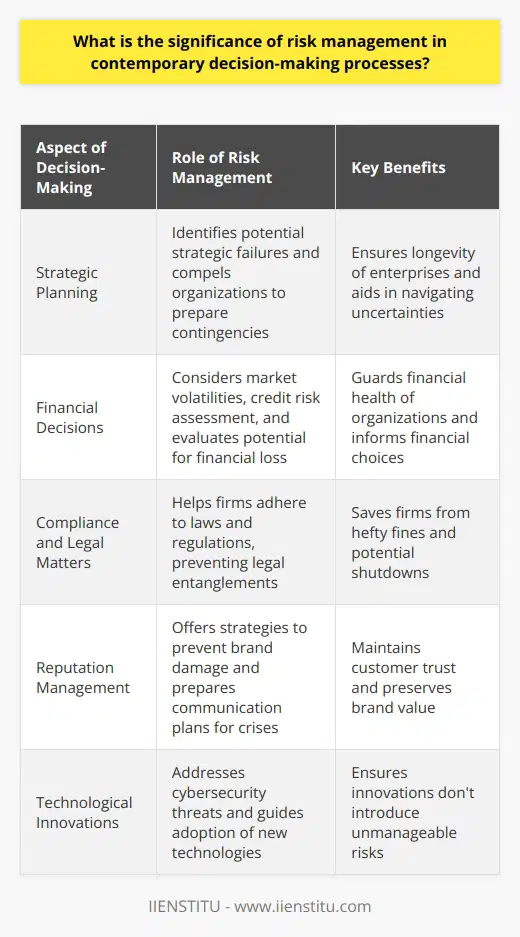
How does the application of risk management principles affect the outcomes of policy and strategic decisions within a business environment?
Understanding Risk Management
Risk management involves identifying, assessing, and prioritizing risks. It also encompasses the application of resources to control the impact of unexpected events. The process aims to ensure uncertainty does not deflect endeavors from business goals.
Impact on Policy Decisions
Enhancing Decision Quality
In policy-making, risk management principles improve the quality of decisions. They prompt policy makers to consider the full landscape of potential risks. This approach leads to more robust and resilient policies.
Promoting Proactive Thinking
By applying risk management, businesses adopt a proactive stance. They anticipate problems before they arise. Policy decisions thus reflect a forward-thinking mindset, mitigating potential future crises.
Aligning with Business Objectives
Risk management aligns policies with the strategic objectives of the business. It ensures that policies support the business's vision while managing potential drawbacks.
Impact on Strategic Decisions
Guiding Strategic Planning
Strategic decisions involve long-term planning and commitment of resources. Here, risk management serves as a guide. It helps strategists foresee varying scenarios and prepare accordingly.
Balancing Opportunities and Risks
Effective risk management helps to strike a balance. It weighs the potential gains against possible losses. Businesses can pursue opportunities while keeping risks in check.
Fostering Sustainable Growth
When businesses take calculated risks, they position themselves for sustainable growth. Risk management embeds this calculated approach into strategic decision-making.
Final Thoughts
Risk management is not just about avoiding adverse outcomes. It also involves seizing opportunities with an informed understanding of risks. This dual function shapes more successful and resilient business strategies and policies.
Applying risk management principles thus fundamentally shifts how businesses approach both policy and strategic decisions. This shift leads to enhanced outcomes, greater agility, and a stronger competitive edge in the dynamic business environment.
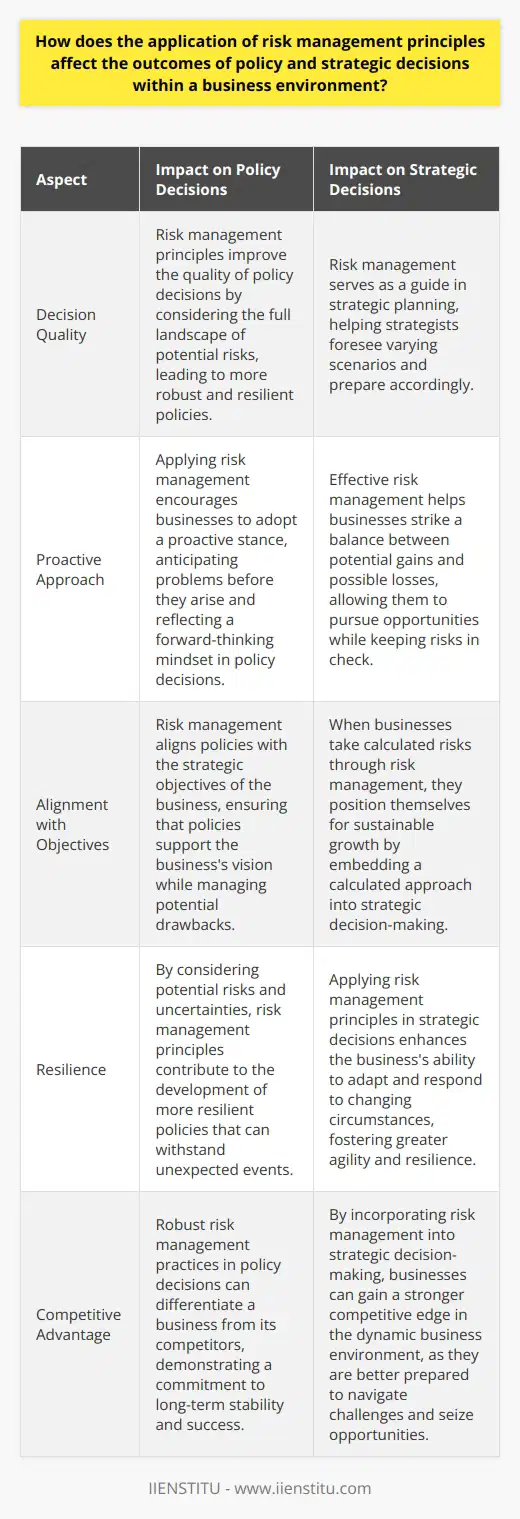
Could you elaborate on the different methodologies and tools in risk management that aid in sophisticated decision-making?
Introduction to Risk Management Tools and Methodologies
Effective risk management stands crucial in decision-making. It enables organizations to tackle potential threats. They also capitalize on opportunities. These actions lead to achieving their goals.
Identifying Risk: The Foundation
Risk identification starts the risk management process. It involves recognizing potential threats. Opportunities also fall into this category. Tools to aid this step include:
- Brainstorming Sessions: These encourage free-thinking. Ideas on potential risks emerge.
- Checklists: Drawn from historical data. Checklists represent typical risks in similar projects.
- Interviews: Experts provide insights on possible risks.
- SWOT Analysis: Strengths, Weaknesses, Opportunities, Threats. This helps in understanding internal and external factors.
- Delphi Technique: Relies on consensus from experts. They forecast potential risks.
Analyzing Risk: Understanding the Impact
Once risks are identified, analysis follows. This step measures potential impact. Probability estimation is also part of this. Methods include:
Qualitative Analysis
- Risk Probability and Impact Matrix: It charts likelihood against consequence. Thus, it offers a visual aid.
- Risk Register: This document lists identified risks. It describes, categorizes, and prioritizes them.
Quantitative Analysis
- Monte Carlo Simulations: They use probability distribution. This predicts multiple outcomes.
- Decision Tree Analysis: It maps possible decisions to outcomes. It calculates expected values for each path.
Planning Risk Responses: Preparing for Uncertainty
Effective planning is key. It shapes the actions to manage risks. Common responses include:
- Avoidance: Changing plans to evade the risk.
- Transference: Passing the risk to a third party.
- Mitigation: Reducing the likelihood or impact.
- Acceptance: Acknowledging the risk and not changing plans.
Monitoring and Review: The Cycle of Improvement
Continuous monitoring ensures risks remain under control. Review processes also adapt strategies as needed. Tools include:
- Risk Audits: These examine the effectiveness of the strategy.
- Performance Reviews: They evaluate how risk responses are working.
- Variance and Trend Analysis: This examines project performance. It detects any deviations from plan.
Technology in Risk Management: Sophistication at Hand
Technology offers sophisticated tools. They aid in automating and improving risk management.
- Risk Management Software: Provides an integrated platform. It monitors risks and stores data.
- Dashboards: Give real-time data. They enable quick decisions.
- Artificial Intelligence: AI can predict risks. It analyses data faster than humans.
Conclusion: Informed Decision-Making for Success
Risk management methodologies and tools are vital. They make informed and sophisticated decision-making possible. This process continuously evolves. It incorporates new practices and technologies. Organizations thus become more resilient. They are better equipped to face uncertainty.

